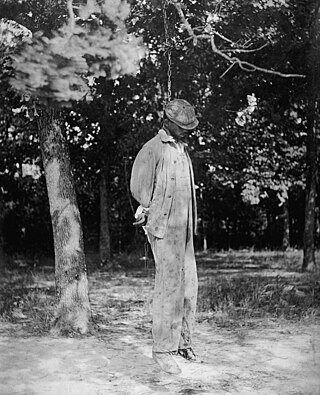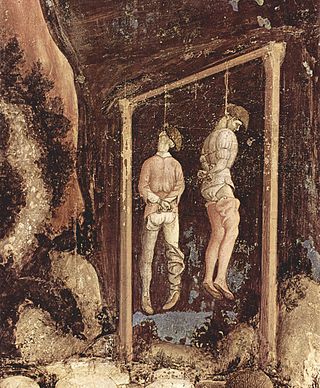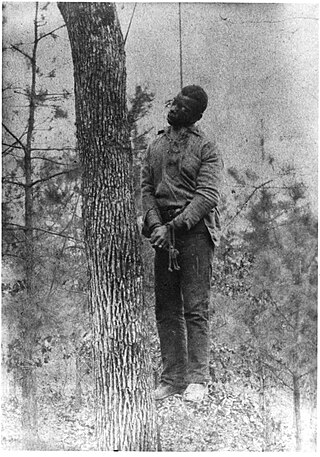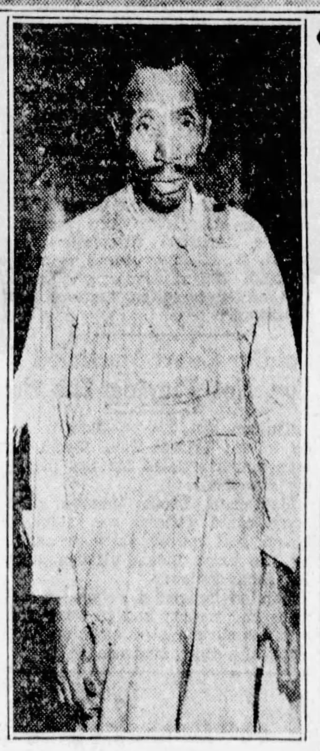
Lynching is an extrajudicial killing by a group. It is most often used to characterize informal public executions by a mob in order to punish an alleged transgressor, punish a convicted transgressor, or intimidate people. It can also be an extreme form of informal group social control, and it is often conducted with the display of a public spectacle for maximum intimidation. Instances of lynchings and similar mob violence can be found in every society.

Hanging is killing a person by suspending them from the neck with a noose or ligature. Hanging has been a common method of capital punishment since the Middle Ages, and is the primary execution method in numerous countries and regions. The first known account of execution by hanging is in Homer's Odyssey. Hanging is also a method of suicide.

Lynching was the widespread occurrence of extrajudicial killings which began in the United States' pre–Civil War South in the 1830s and ended during the civil rights movement in the 1950s and 1960s. Although the victims of lynchings were members of various ethnicities, after roughly 4 million enslaved African Americans were emancipated, they became the primary targets of white Southerners. Lynchings in the U.S. reached their height from the 1890s to the 1920s, and they primarily victimised ethnic minorities. Most of the lynchings occurred in the American South, as the majority of African Americans lived there, but racially motivated lynchings also occurred in the Midwest and border states. In 1891, the largest single mass lynching in American history was perpetrated in New Orleans against Italian immigrants.
Wrongful execution is a miscarriage of justice occurring when an innocent person is put to death by capital punishment. Cases of wrongful execution are cited as an argument by opponents of capital punishment, while proponents say that the argument of innocence concerns the credibility of the justice system as a whole and does not solely undermine the use of the death penalty.

Edwin Porch Morrow was an American politician, who served as the 40th Governor of Kentucky from 1919 to 1923. He was the only Republican elected to this office between 1907 and 1927. He championed the typical Republican causes of his day, namely equal rights for African-Americans and the use of force to quell violence. Morrow had been schooled in his party's principles by his father, Thomas Z. Morrow, who was its candidate for governor in 1883, and his uncle, William O. Bradley, who was elected governor in 1895. Both men were founding members of the Republican Party in Kentucky.

Jesse Washington was a seventeen-year-old African American farmhand who was lynched in the county seat of Waco, Texas, on May 15, 1916, in what became a well-known example of lynching. Washington was convicted of raping and murdering Lucy Fryer, the wife of his white employer in rural Robinson, Texas. He was chained by his neck and dragged out of the county court by observers. He was then paraded through the street, all while being stabbed and beaten, before being held down and castrated. He was then lynched in front of Waco's city hall.
On May 16, 1918, a plantation owner was murdered, prompting a manhunt which resulted in a series of lynchings in May 1918 in southern Georgia, United States. White people killed at least 13 black people during the next two weeks. Among those killed were Hazel "Hayes" Turner and his wife, Mary Turner. Hayes was killed on May 18, and the next day, his pregnant wife Mary was strung up by her feet, doused with gasoline and oil then set on fire. Mary's unborn child was cut from her abdomen and stomped to death. Her body was then repeatedly shot. No one was ever convicted of her lynching.

Anthony Allen Shore was an American serial killer and child molester who was responsible for the murders of one woman and three girls. He was active from 1986 to 2000, and became known as the "Tourniquet Killer" because of his use of a ligature with either a toothbrush or bamboo stick to tighten or loosen the ligature. The instrument was similar to a garotte or a twitch, a tool used by farmers to control horses. Shore was sentenced to death in 2004, and executed by lethal injection on January 18, 2018.

The Perry massacre was a racially motivated conflict in Perry, Florida, in December 1922. Whites killed four black men, including Charles Wright, who was lynched by being burned at the stake, and they also destroyed several buildings in the black community of Perry after the murder of Ruby Hendry, a white female schoolteacher.

Patricia Bernstein is an American writer and public relations expert. She is best known for her books Ten Dollars to Hate: The Texas Man Who Fought the Klan, The First Waco Horror: The Lynching of Jesse Washington and the Rise of the NAACP, and debut novel, A Noble Cunning: The Countess and the Tower.
Samuel "Mingo Jack" Johnson was an African American man falsely accused of rape. He was brutally beaten and hanged by a mob of white men in Eatontown, New Jersey.
Capital punishment has never been practiced Alaska throughout its history as a state, as it was abolished in 1957. Between December 28, 1869, and April 14, 1950, between the Department, District, and Territory of Alaska, twelve felons, all male, were executed by hanging for murder, robbery, and other crimes. Some were European, some were Native American, and two were African. The territorial legislature abolished capital punishment in 1957 during preparations for statehood, making Alaska the first in the West Coast of the United States to outlaw executions, along with Hawaii, which did the same.
La Matanza and the Hora de Sangre was a period of anti-Mexican violence in Texas, including lynchings and massacres, between 1910 and 1920 in the midst of tensions between the United States and Mexico during the Mexican Revolution. This violence was committed by Anglo-Texan vigilantes, and law enforcement, such as the Texas Rangers, during operations against bandit raids known as the Bandit Wars. The violence and denial of civil liberties during this period was justified by racism. Ranger violence reached its peak from 1915 to 1919, in response to increasing conflict, initially because of the Plan de San Diego, by Mexican and Tejano insurgents to take Texas. This period was referred to as the Hora de Sangre by Mexicans in South Texas, many of whom fled to Mexico to escape the violence. At least 300 Mexican Americans were killed in Texas during the 1910s, with total estimates of ranging from hundreds to thousands killed. At least 100 Mexican Americans were lynched in the 1910s, many in Texas. Many murders were concealed and went unreported, with some in South Texas, suspected by Rangers of supporting rebels, being placed on blacklists and often "disappearing".

James Harvey and Joe Jordan were two African-American men who were lynched on July 1, 1922, in Liberty County, Georgia, United States. They were seized by a mob of about 50 people and hanged while being transported by police from Wayne County to a jail in Savannah. Investigations by the NAACP showed that the police involved were complicit in their abduction by the mob. Twenty-two men were later indicted for the lynching, with four convicted.
The hanging of Charles Blackman occurred in Ellaville, Georgia, on January 25, 1889. Stonewall Tondee, a white man, had been murdered on September 5, 1885. Charles Blackman, an African-American man, was tried and convicted for the murder in three trials by all-white, "gentleman" juries. The Georgia Supreme Court twice granted Blackman a new trial, but he was convicted and sentenced to hang a third time in September 1888. Blackman was twice granted respite by Georgia Governor John Brown Gordon after the third trial, which delayed Blackman’s execution by three months. Blackman maintained his innocence until his public execution and insisted that he was never given an impartial trial. 5,000 people from across South Georgia travelled to Ellaville, a town of a few hundreds, to witness the hanging. Telegraph wires were cut to ensure that messages from Governor Gordon and other state officials would not be transmitted and interfere with the hanging.

Asbury Respus was an American serial killer who confessed to at least eight murders throughout North Carolina and Virginia in the early 20th century. Respus was not a suspect in most of the murders he committed until he gave a lengthy confession during his trial for the murder of 9-year-old Vera Leonard, the murder for which he would be executed. Respus's victim profile was particularly unique in that his victims were not of a particular age or racial group, as four were white, four were black, two were children, and one was over 80 years old. Respus was executed in the electric chair at the Central Prison in Raleigh in 1932.

Jesse Thomas was a 23-year-old, African-American man who was murdered in Waco, McLennan County, Texas by Sam Harris on May 26, 1922. A large mob then seized the body from the undertaker and burnt it in Waco's public square. The lynching of Jesse Thomas was the 10th lynching in 20-days in Texas and according to the United States Senate Committee on the Judiciary it was the 30th of 61 lynchings during 1922 in the United States.

Francis Marion Snow, also known as the Butcher of Stephenville, was a family annihilator who murdered his wife, mother-in-law, and step-son on November 27, 1925, near Selden, Texas, after an argument. He was convicted of these murders and executed on August 12, 1927. Snow is also suspected of committing several other murders.
Herbert L. Copeland was an American murderer and self-confessed serial killer who was tried, sentenced to death and executed for killing two deputies and a police officer in the District of Columbia in 1918. Moments before being executed, Copeland confessed that he had killed 12 people in various states throughout his lifetime, but none of these could be definitively proven.